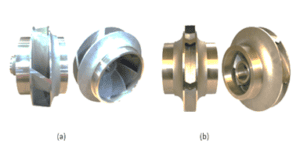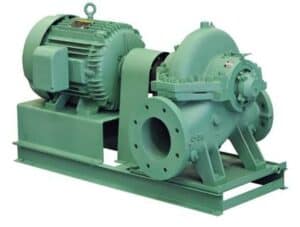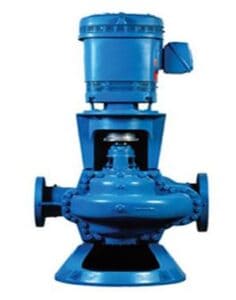Horizontal &Vertical Split Case Centrifugal Pump
What are horizontal & vertical split case centrifugal pumps?
Horizontal & vertical split case centrifugal pumps are unique rotodynamic pumps whose pump casings are divided into two halves. The suction and discharge nozzles lay side by side on the bottom half of the chamber. The pump casings can be split horizontally or vertically relative to the impeller, resulting in either a horizontal split case centrifugal pump or a vertical split case centrifugal pump. The split case design allows for quick dismantling, repair, and maintenance of pump components. The manufacturers of the horizontal & Vertical split case centrifugal pump create the pumps with a between-bearing design, where the rotor suspends between two bearings, one on each side. Horizontal &Vertical split case pumps provide great performance metrics with pump capacity as high as 6000 cubic meters per hour and a maximum pressure head of 200 meters. They primarily apply in transporting water and relatively thin pumped media and suit applications requiring higher fluid flow rates than the convectional end suction pumps can deliver.

Figure: Showing the configuration of a horizontal split case centrifugal pump

Figure: Showing the configuration of a vertical split case centrifugal pump
Components of horizontal & vertical split case centrifugal pumps
Electric motor
The horizontal & vertical split case centrifugal pumps can work using an alternating current motor, either a single-phase or a three-phase induction motor. The electric motor is the source of power for the pump. It works by converting the electrical energy supply into mechanical torque output, which is transmitted to the pump head.
Casing
The casing is a stationary component housing the rotor assembly and carrying the suction and discharge ports. The pump casing contains the liquid and directs the fluid flow in and out of the pump through the suction and delivery pipes. The pump casing also serves as a pressure containment vessel. In the horizontal & vertical split case centrifugal pumps, the housing is divided into two chambers held together by bolts. For the former, the joint is flat, while the latter is vertical.
Figure: Showing a horizontally split pump casing.
Figure: Showing a vertically split pump casing.
Coupling
Horizontal & vertical split case centrifugal pump manufacturers mostly use a long coupling for the pump to help with easy pump assembly and maintenance. The long coupling links the motor’s driver shaft with the rotating pump shaft, facilitating the transfer of mechanical torque to the pump head with minimal losses.
Shaft
The shaft is a rotary mechanical component supported on bearings. Its main functions are to carry the impeller. It is usually coupled with the prime mover. The horizontal and vertical split case centrifugal pump manufacturers make the shaft using high-grade materials such as stainless steel and alloy steel material because they overcome corrosion and vibrations during pump operation.
Impeller
The impeller is the main rotary component featuring backward curved vanes. Its function is to increase the kinetic energy and pressure of the fluid to move through the pump. In the horizontal and vertical split case centrifugal pump, the impeller rides on a shaft that suspends between two bearings, which offer support on either side. These units use a closed-type impeller because it is rigid and has high hydrodynamic efficiency. A closed impeller can be either a single-suction or double-suction impeller.
Figure: Showing closed pump impellers; (a) single-suction design and (b) double-suction design.
Bearings
The bearings support the pump shaft or the rotor assembly and align them correctly with the fixed ends under the action of radial and axial forces. They also help to contain the rotor’s relative motion and minimize the friction between the rotating shaft and the stator.
How do horizontal & vertical split case centrifugal pumps work?
When the electric motor starts, the rotary motion is transferred from the motor shaft to the impeller via coupling and pump shaft. As the impeller rotates, a vacuum is created inside the pump, allowing the pumped fluid to flow into the pump casing and toward the impeller’s eye due to the external atmospheric pressure. Once the liquid strikes the impeller, the centrifugal force acting on the impeller blades moves it radially and axially outwards at high tangential velocity until it passes all the impeller components. The swirling flow at the exit of the impeller then enters into the diffuser, where the extreme fluid flow speed decreases due to the gradually expanding flow path, and the high-velocity energy converts into a high-pressure head. The pumped liquid then discharges from the pump via the pump outlet at elevated pressure, which allows the fluid to transport to the designated location through the delivery pipe connections.

Figure: Working of a horizontal & vertical split case centrifugal pump
Types of horizontal & vertical split case centrifugal pumps
Single-suction horizontal & vertical split case centrifugal pump
The single-suction horizontal & vertical split case centrifugal pumps contain a single inlet impeller. The pumped liquid flows into the pump inlet, and the whole volume enters single inlet impeller blades from one side. The centrifugal effect generates fluid pressure as the blades displace the liquid through the pump. These pumps are known for their less complex design and low cost.
Figure: Showing a single-suction horizontal split case centrifugal pump.
Figure: Showing a single-suction vertical split case centrifugal pump.
Double suction horizontal & vertical split case centrifugal pump
The double-suction horizontal & vertical split case centrifugal pumps feature a double-inlet impeller that admits water from both sides of the blades. The double inlet impeller comprises two back-to-back-impellers which help to split the flow inside the pump, sending 50% of the flow through either eye. The double-suction horizontal & vertical split case centrifugal pumps experience lower axial thrust and provide better Net Positive Suction Head (NPSH) than the single-suction counterparts.
Applications of horizontal & vertical split case centrifugal pumps
The horizontal & vertical split case centrifugal pumps suit various industrial applications, including agriculture, chemical, petrochemical, and wastewater plants. Typical uses include the following:
- Horizontal &vertical split case centrifugal pumps are used in water supply systems to move water at a high flow rate and low to medium pressure.
- They are used to transport low-viscosity liquids such as clear water and unsaturated wastewater from industrial processes at average heads
- They are used as fire pumps.
- They are used as booster pumps in booster stations.
- They are sued to supply plant makeup water and cooling water.
- They are used to handle condensate.
Advantages of horizontal & vertical split case centrifugal pumps
- Horizontal & Vertical split-case centrifugal pumps have high reliability and energy efficiency.
- The split casing design increases suction performance and balances the hydraulic axial forces. This ultimately boosts the bearing life and improves the pump’s reliability.
- They can manage much greater high flow rates than conventional end suction pumps.
- They are more robust and fit for continuous use because the additional bearing assembly in the pump head saves a significant level of strain from the motor during operation.
- Horizontal & vertical split case centrifugal pump saves repair/servicing time. The split casing design allows easy dismantling of the rotor assembly without disturbing the pump alignment, saving time during repair or maintenance.
- The long coupling maintains a sufficient distance between the motor and the pump head, preventing the pumped fluid from ingressing into the prime mover in case of mechanical seal failure.
- The horizontal & vertical split case centrifugal pumps are easy to maintain because the long coupling allows access to the pump head without removing the motor.
- These pumps have separate motors and pump shafts; hence only one of them will need to be replaced if damaged.
Disadvantages of horizontal & vertical split case centrifugal pumps
- Horizontal and vertical split case centrifugal pumps are unsuitable for moving high-viscosity liquids and liquids containing large suspended solids.
- They are prone to corrosion due to leakage in mechanical seals.
- They may fail under intense loading.
Troubleshooting horizontal & vertical split case centrifugal pump
The motor fails to start
- The motor is defective. Inspect and replace the prime mover if it is necessary.
- There is an open circuit in the thermal overload. Allow the vertical split case centrifugal pump to cool, close any open circuit, and restart the unit.
- There is a tripped circuit breaker or a blown-out fuse. Inspect and reset the circuit breaker if necessary. Inspect the pump for a blown-out fuse and replace it.
- The motor is poorly installed. Ensure the pump is installed to the horizontal & vertical split case centrifugal pumps manufacturers’ standards.
The pump’s driver is overloaded
- The Pump speed is too high. Ensure the pump operates within the speed range specified by manufacturers of the horizontal & vertical split case centrifugal pumps.
- Some pump parts are experiencing extreme mechanical friction. Inspect the pump assembly for any deflection or obstruction and correct it.
- Faulty pump motor. Inspect the prime mover for defects and repair or replace them if necessary.
The pump provides insufficient discharge after start-up
- The impeller or check valve is clogged. Inspect and clear any blockage in the valve or impeller.
- There is air in the pump or suction pipework. Be sure to fill the pump or piping network with water to drive out the air.
- The monomeric head is insufficient due to high friction losses that exceed the pump design. Increase the pump power. Ensure the pipes used in the piping network meet the diameter recommended by manufacturers of the horizontal &vertical split case centrifugal pumps.
- The pump’s operation is reversed. Ensure that the motor rotates in the direction of the arrow provided on the pump casing.
The pump is experiencing excessive vibration
- Some of the horizontal & vertical split case centrifugal pumps’ components are unbalanced. Inspect and rebalance the parts as necessary.
- The pump impeller is partially clogged. Inspect and clean the impeller.
- Some pump components are loosely mounted in the pump body. Tighten any loose parts to the torque level recommended by the manufacturers of the horizontal and vertical split case centrifugal pump.
- The pump shaft is oblique or unbalanced. Inspect the post, rebalance it as required, or replace it.
- The impeller is damaged. Inspect and replace the impeller.
- The bearings are worn-out. Replace the bearings.
The noise level is too high
- The impeller is damaged or worn out. Inspect and replace the impeller.
- Some foreign materials are present in the horizontal &vertical split case centrifugal pumps. Disassemble the pump and clean it.
- The pump is working outside the duty range. Check that the duty range is correct according to the manual provided by the manufacturers of the horizontal &vertical split case centrifugal pump.
- The mounting plate and the foundation lack sufficient rigidity. Reinforce the foundation, and mount the horizontal & vertical split case centrifugal pumps tightly.
- Pump working in cavitation. Check that the suction line valves are fully open.
Summary
Horizontal & vertical split case centrifugal pumps are unique types of rotodynamic pumps containing a pump casing that is divided into two halves and suction and discharge nozzles on either side of the bottom half of the chamber. The pump casings can be split horizontally or vertically relative to the impeller, creating either a horizontal split case centrifugal pump or a vertical split case centrifugal pump. The split case design allows for quick dismantling and repair of the pump. The horizontal & vertical split case centrifugal pump manufacturers fit the pumps with a between-bearing design to provide additional rotor support. They are perfect for applications requiring higher fluid flow rates than the convectional end suction pumps can deliver. Horizontal & Vertical split case centrifugal pumps are primarily used with water and relatively thin pumped media. They suit various industrial applications, including irrigation, water recirculation, and wastewater plants. They have superior suction performance and balanced hydraulic axial forces, enhancing the bearings’ service life and pump reliability.





